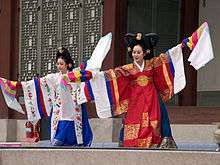Taepyeongmu
| Taepyeongmu | |
 | |
| Korean name | |
|---|---|
| Hangul | 태평무 |
| Hanja | 太平舞 |
| Revised Romanization | Taepyeongmu |
| McCune–Reischauer | T‘aep‘yŏngmu |
Taepyeongmu (태평무; literally "great peace dance") is a Korean dance with the function of wishing a great peace for the country. Its exact origin is unknown, but Hahn Seongjun (hangul: 한성준; hanja: 韓成俊; 1875–1941), a well known dancer and drummer, rearranged the dance in the early 20th century. There are three assumptions regarding the origin of Taepyeongmu. One is a court dance occasionally performed by kings during the Joseon dynasty. Therefore, the costumes used by the dancers are similar to the gwanbok (hangul: 관복; literally "official clothing") formerly worn by Korea's kings and queens.[1]
Taepyeongmu is designated as one of the Important Intangible Cultural Properties of South Korea. Famous practitioners have included Han Young-suk, designated a Living National Treasure for her performances.[2]
See also
| Wikimedia Commons has media related to Taepyeongmu. |
References
- ↑ Kim Eunhee. "Reflecting Korean dance:Taepyeongmu" (in Korean). The National Center for Korean Traditional Performing Arts. Archived from the original on 2008-06-09. Retrieved 2007-12-04.
- ↑ "한영숙" [Han Young-suk] (in Korean). DAUM. Retrieved 24 July 2017.
External links
- General information and related clip about Taepyeongmu at Seoul Metropolitan Government
- Taepyeongmu Initiation Hall's Saturday Regular Performance Korea Tourism Organization
- (in Korean)Taepyeongmu official site